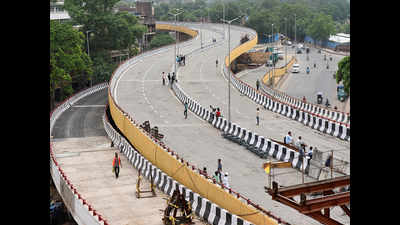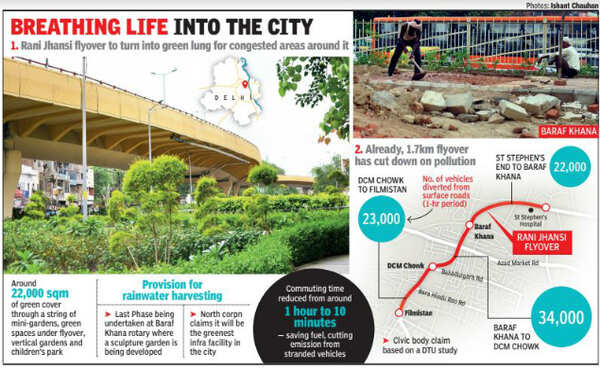- News
- City News
- delhi News
- Delhi: After untying traffic knots, Rani Jhansi flyover now goes green
Trending
This story is from July 30, 2019
Delhi: After untying traffic knots, Rani Jhansi flyover now goes green
With the monsoon in full swing in the city, dozens of workers are busy turning the Baraf Khana Chowk rotary — a site known for massive traffic jams and choking pollution — into a park for locals. This is the final phase of a project to give the Rani Jhansi flyover in north Delhi a green makeover.

Rani Jhansi flyover
NEW DELHI: With the monsoon in full swing in the city, dozens of workers are busy turning the Baraf Khana Chowk rotary — a site known for massive traffic jams and choking pollution — into a park for locals. This is the final phase of a project to give the Rani Jhansi flyover in north Delhi a green makeover.

“We want the flyover to turn into the much needed ‘green lungs’ for this congested area in Old Delhi. The over-5-acre green space will make the flyover the greenest infrastructure project in Delhi,” said a senior official of North Delhi Municipal Corporation’s engineering department.
A children’s park, a sculpture garden and vertical climbers are among the facilities being developed along the 1.7km-long flyover, which was launched last October after missing many deadlines. “The children’s park and a manicured garden have been completed near DCM Chowk while the facility at Baraf Khana Chowk will have sitting decks and sculptures,” the official said.
Residents in the neighbourhood confirmed the marked improvement in the ambient air quality. Md Mujahid (45), who stays near the DCM Chowk police station, said, “We could not breathe here freely for almost a decade. People had to cover their faces due to dust but now many come to use these parks for walking, some use them to just idle around.”
Down the road, Om Prakash (62), who runs a shop on the Baraf Khana rotary, hopes that the space will no longer be used by addicts. “For decades, the Baraf Khana and Azad markets had been synonymous with traffic jams. People avoided these markets as they didn’t want to waste time. The air is also much cleaner now,” he said.
The Baraf Khana phase of greening, estimated to cost around Rs 34 lakh, is expected to be completed in a month. The corporation is also setting up rainwater harvesting provisions to improve the groundwater levels in the area. “We have decided to install creepers rather than mini plants on 34 pillars of the flyover. The rest of the space is being used to create parking space for 400 vehicles on Bhadurgarh Road and Rani Jhansi Road,” the official said.
According to the DTU study, 23,389 PCUs (passenger car units) are using the DCM Chowk-Filmistan Cinema stretch every hour while 34,327 vehicles are plying on the Baraf Khana-DCM Chowk stretch and 22,401 vehicles on the St Stephen’s Hospital-Baraf Khana section. “Considering a 12-hour period, over 4 lakh cars have shifted from the surface level to the flyover, improving ambient air quality levels for residents and shopkeepers,” the official said.
If the public works department closes the U-turns on the stretch beyond Tis Hazari Courts, the benefits will multiply, the official added.

“We want the flyover to turn into the much needed ‘green lungs’ for this congested area in Old Delhi. The over-5-acre green space will make the flyover the greenest infrastructure project in Delhi,” said a senior official of North Delhi Municipal Corporation’s engineering department.
A children’s park, a sculpture garden and vertical climbers are among the facilities being developed along the 1.7km-long flyover, which was launched last October after missing many deadlines. “The children’s park and a manicured garden have been completed near DCM Chowk while the facility at Baraf Khana Chowk will have sitting decks and sculptures,” the official said.
The flyover has already brought down the air pollution levels in the area as the travel time on the stretch has come down from 40 minutes-1 hour to just 10 minutes, he pointed out. “There have been huge savings in terms of fuel and human hours. A Delhi Technological University (DTU) study reveals that lakhs of vehicles are using the flyover.”
Residents in the neighbourhood confirmed the marked improvement in the ambient air quality. Md Mujahid (45), who stays near the DCM Chowk police station, said, “We could not breathe here freely for almost a decade. People had to cover their faces due to dust but now many come to use these parks for walking, some use them to just idle around.”
Down the road, Om Prakash (62), who runs a shop on the Baraf Khana rotary, hopes that the space will no longer be used by addicts. “For decades, the Baraf Khana and Azad markets had been synonymous with traffic jams. People avoided these markets as they didn’t want to waste time. The air is also much cleaner now,” he said.
The Baraf Khana phase of greening, estimated to cost around Rs 34 lakh, is expected to be completed in a month. The corporation is also setting up rainwater harvesting provisions to improve the groundwater levels in the area. “We have decided to install creepers rather than mini plants on 34 pillars of the flyover. The rest of the space is being used to create parking space for 400 vehicles on Bhadurgarh Road and Rani Jhansi Road,” the official said.
According to the DTU study, 23,389 PCUs (passenger car units) are using the DCM Chowk-Filmistan Cinema stretch every hour while 34,327 vehicles are plying on the Baraf Khana-DCM Chowk stretch and 22,401 vehicles on the St Stephen’s Hospital-Baraf Khana section. “Considering a 12-hour period, over 4 lakh cars have shifted from the surface level to the flyover, improving ambient air quality levels for residents and shopkeepers,” the official said.
If the public works department closes the U-turns on the stretch beyond Tis Hazari Courts, the benefits will multiply, the official added.
End of Article
FOLLOW US ON SOCIAL MEDIA










